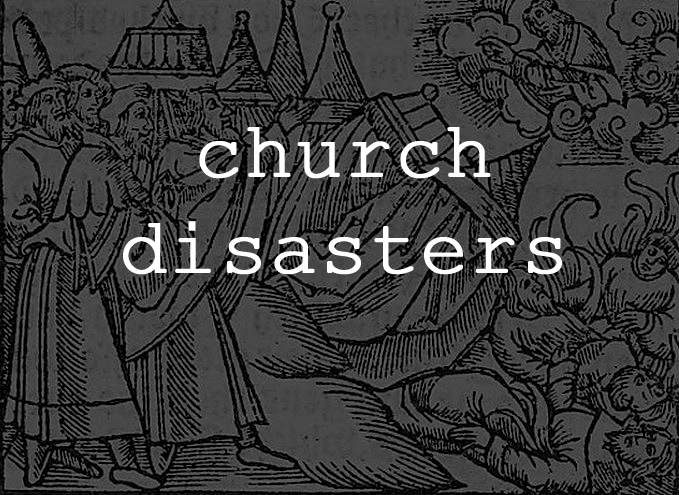Five Levels of Church Disasters

Sam Rainer
She was adamant about going through with the baptism. I tried to convince her to put it off a week. The heating element in the baptistery had gone out. It was January. The morning’s temperature was somewhere below zero.
It wasn’t a crisis, but it felt like it. We spent the Bible study hour boiling water and pouring it into the fiberglass pool, pot by pot. The effort helped. At least some of the chunks of ice melted. The church gasped with her when she came up out of the water.
Leadership is boring without a few crises every now and then. The drama kings and queens keep things interesting. Unforeseen events keep leaders fresh. I’ll never forget the time my church was struck by lightning… twice in a month. Our insurance agent didn’t question the claim, but he was concerned about our faithfulness.
Leadership discernment involves both an internal and external element. Internally, leaders must have self-awareness. Without an understanding of your own internal processes, it’s impossible to discern how to react to external pressures. Externally, leaders also must understand the degree of disaster. If you react to a cat stuck in a tree with the same level of urgency as a five-alarm fire, then it’s best not to apply for a position at the local fire station (cats are a nuisance anyway).
If fire departments have ways of determining a level of response, and if the Enhanced Fujita Scale can determine the damage level of a tornado, then church leaders should be able to discern the level of a church crisis and its potential damage. I’ll start this conversation with five levels of church disaster. The first level is a demand, not a need. Levels three, four, and five are true needs. The fifth level represents disaster.
D1: Immediate demand with no lasting impact. On occasion, people can make demands as if the tsunami wave is only seconds from impact. This disaster exist only in the head of the person making the demand. It’s real to them, so you must react. But as the leader, you cannot feed off their urgency. For example, few things get people riled like a missing coffee pot. It creates immediate demands, but the lasting impact to the church is minimal. You really should find the missing coffee pot, but not everything needs to stop while you look for it.
D2: Immediate need affecting a few people. As a pastor, I often receive requests to be with a family during the loss of a loved one. Most congregants do not demand the presence of a pastor, but it is a heightened level of response. I want to be there; most want me there. Though the loss of a loved one can have a lasting impact on a few families, it is not often such a loss affects the entire church for an extended amount of time. Church leaders should care for hurting people. But not every death in the church is a dire crisis. In fact, I’ve preached at many funerals that were just as much celebrations of faithfulness as they were times of grief.
D3: Urgent need with lasting impact. I once worked with a church that was weeks away from default. The bank froze assets. Foreclosure was a word actually used in conversations. Few in the church knew about the serious deterioration of the church’s finances. This level of disaster has the potential to burden the church for a long time.
D4: Urgent need with lasting impact affecting many people. A few weeks ago in my community, someone came into a local church, shot two people, and then committed suicide. It rocked the church. It jarred the community. This local church will survive. Dealing with such a crisis, however, requires several churches and their leaders coming together.
D5: True disaster affecting the entire church. When the world opens up and swallows Korah and Dathan, it gets the attention of everyone. This disaster can permanently destroy a church. The difference between this disaster level and others, however, is that church leaders cause these crises. Your moral failure, your greed, or your lack of willingness to be held accountable are the cracks that will open up and swallow your church whole. Of course, many churches survive terrible pastors. But no person can more quickly destroy the church than her senior leaders.
Internally, be self-aware. Externally, fine-tune your discernment. And check the heating element in the baptistery this week.







Question about a D3-level disaster: How much do you believe that the congregation needs to know about a financial crisis? And how soon?
I volunteer in a small church where the tithes are barely enough to cover the salaries of staff, and there have been months where the staff take half-pay, or no pay. When there is theft in the church, there is no money to replace what was stolen. It’s not a foreclosure situation, but only because the church does not believe in borrowing money. The congregation has not been told. I believe the finances of the church are the business of the whole church, but had a hard time making a case for this from scripture, and so besides trying to persuade the pastors to be transparent, I have not felt free to share this information with anyone.
Marie – Thanks for your question. I believe leaders should be more transparent than not. And the sooner you can tell the congregation about major financial problems, the better. As serious as you case seems, I would pull in key influences and ask them how best to tell the entire congregation.